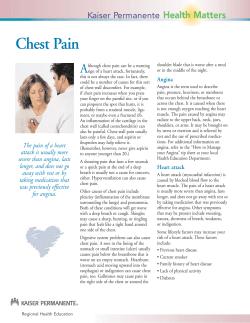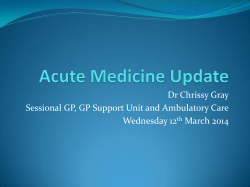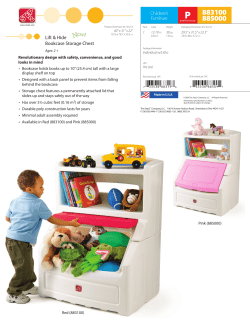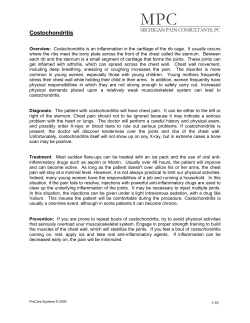
Bradycardia Portage County EMS Patient Care Guidelines
Portage County EMS Patient Care Guidelines Bradycardia Note: • • • Hypoxia is the # 1 cause of bradycardia in children primarily < 8 years of age. Maintain adequate oxygenation and ventilation. Bradycardia may also be caused by allergic reactions, hypothermia, and medication ingestion or poisoning. Use size-based resuscitation reference (i.e. Broselow Tape) for all pediatric medication dose calculations. Priorities Chief Complaint LOPQRST AS/PN AMPL Initial Exam Detailed Focused Exam Data Goals of Therapy Monitoring Assessment Findings Syncope, weakness, diaphoresis, unresponsiveness, chest pain, dizziness, poor feeding in infants Identify location and radiation, onset, duration progression and severity, presence of intermittent or fluctuating symptoms, factors that provoke (exertion) or palliate (rest) the pain. Chest pain, dyspnea, nausea/vomiting. Pain that is aggravated by breathing and coughing (pleuritic). Cough and fever/chills. History of coronary artery disease or risk factors for it. Use of cardiac medications, including aspirin. History of pacemaker placement. Check ABCs and correct any immediate life threatening problems. Vital Signs: BP, HR, RR, Temp, SpO2 General Appearance: Anxious? Skin: Cool, pale diaphoretic? Neck: JVD? Chest: Laboring to breathe? Lungs: Wheezes, rales, rhonchi? Decreased breath sounds? Heart: Rate, regularity? Legs: Pedal Edema? Neuro: ALOC? SpO2, 12-lead EKG, blood glucose, ETCO2 Improve cardiovascular status, reduce chest pain, reduce risk of lethal arrhythmias, early identification of myocardial infarction, and early identification of acute coronary syndrome patients. Cardiac monitoring, SpO2 and capnography EMERGENCY MEDICAL RESPONDER/ EMERGENCY MEDICAL TECHNICIAN • • 3/25/14 Routine Medical Care. Administer oxygen 2 – 4 LPM per nasal cannula if SpO2 < 94%. Increase flow and consider non-rebreather mask to keep SpO2 > 94% Bradycardia Guideline Page 1 of 4 Pediatric • • • Assist ventilations with BVM for unstable patient[1] Assess circulation. Begin chest compressions if bradycardia (or signs of inadequate perfusion) persists after oxygen therapy and o Heart rate < 60 in children 1 – 8 years old o Heart rate < 100 in children < 1 year old o Continue compressions until heart rate > 100 and adequate perfusion evident If the patient is having o Chest pain – Refer to the Chest Pain Guidelines o Shortness of breath – Refer to the Congestive Heart Failure Guidelines o Altered level of consciousness - Check blood glucose level and refer to Altered Level of Consciousness Guidelines Give a status report to the ambulance crew by radio ASAP. ADVANCED EMERGENCY MEDICAL TECHNICIAN • • • IV normal saline @ KVO If the SBP < 100 mmHg or signs of hypovolemia or inadequate perfusion, give a 500 mL (PEDS 20 mL/kg) fluid bolus, and then reassess Cardiac monitor Contact Medical Control for the following: • Additional fluid boluses are needed for persistent hypotension INTERMEDIATE • • If the patient remains hemodynamically and clinically stable[1], observe and monitor. Prepare for transport. Obtain a rhythm strip and 12-lead EKG Adult • If the patient is (becomes) hemodynamically or clinically unstable[1], o Give atropine 0.5 mg IV/IO[2] May repeat atropine 0.5 mg doses every 3 to 5 minutes to a max of 3 mg Consider going directly to transcutaneous pacing (TCP) in patients likely to be unresponsive to atropine, including cardiac transplant patients, second degree type II or third degree block, acute ischemia, or acute MI o If the patient fails to respond to atropine Initiate TCP immediately Consider analgesia Pediatric • • • 3/25/14 If airway and breathing are adequate, and temperature is normal, but heart rate is still < 60 o Give epinephrine 0.01 mg/kg (0.1 ml/kg 1:10,000) IV/IO (preferred) o May repeat epinephrine 0.01 mg/kg every 3 – 5 min o Maximum single dose 1 mg Transmit 12-lead EKG to Medical Control Consider “H’s & T’s” Bradycardia Guideline Page 2 of 4 Pediatric Contact Medical Control for the following: • Additional fluid orders • Consider atropine (0.1 mg/ml) o 0.02 mg/kg; minimum dose 0.1 mg (1 ml) Max dose 0.5 mg (5 ml) every 5 minutes Max dose 1 mg from 6 months to 8 years; 3 mg over 8 years • Repeat doses of epinephrine and/or atropine • If bradycardia persists despite the above measures, initiate transcutaneous pacing at 100 per minute. • Additional pacing orders PARAMEDIC • If the patient is (becomes) hemodynamically or clinically unstable[1] consider dopamine if TCP fails o Start at 10 mcg/kg/min and titrate in 5 mcg/kg/min increments to a systolic BP of 90 mmHg or a diastolic BP > 50 mmHg with good patient mentation, up to a maximum of 20 mcg/kg/min. Contact Medical Control for the following: • Patient fails to respond to TCP • Early notification if a STEMI is apparent on the 12-lead EKG • Epinephrine drip 2-10 mcg/min IV/IO. Mix drip by putting epinephrine 1:1,000, 1 mg (1 ml) in 250 ml NS. • Repeat doses of epinephrine and/or atropine FOOTNOTES: [1] Criteria for characterizing a patient as “unstable”* • Hemodynamic criteria o SBP < 80 mmHg AND heart rate < 60 beats/min • Clinical criteria o Signs of shock (poor perfusion) are present, including ALOC, including syncope, weakness, lightheadedness, fatigue Absent radial pulses Pallor and diaphoresis o Signs of pulmonary edema are present, including Labored breathing Rales (wet lungs) Hypoxia (SpO2 < 90%) o The patient complains of angina • * The American Heart Association ACLS Guidelines refer to this as “serious signs and symptoms”. [2] Use caution in administering atropine in setting of ACS or AMI because increases in heart rate may increase myocardial ischemia 3/25/14 Bradycardia Guideline Page 3 of 4 Date of Origin: 3/25/14 Medical Director Approval: Date of This Revision: Electronically Signed Date of Review: Timothy Vayder, DO, FACOEP 3/25/14 Bradycardia Guideline Page 4 of 4
© Copyright 2025





















